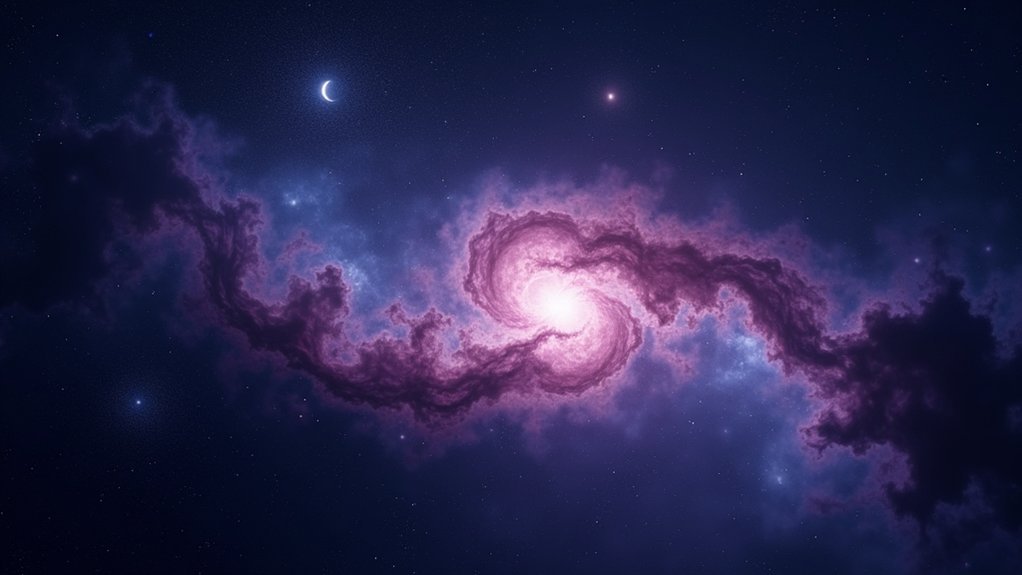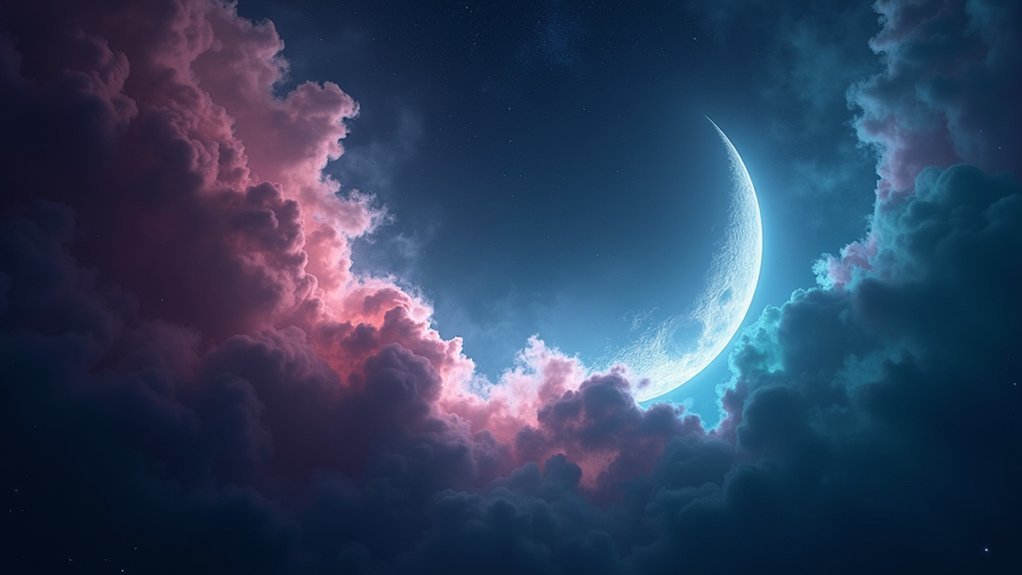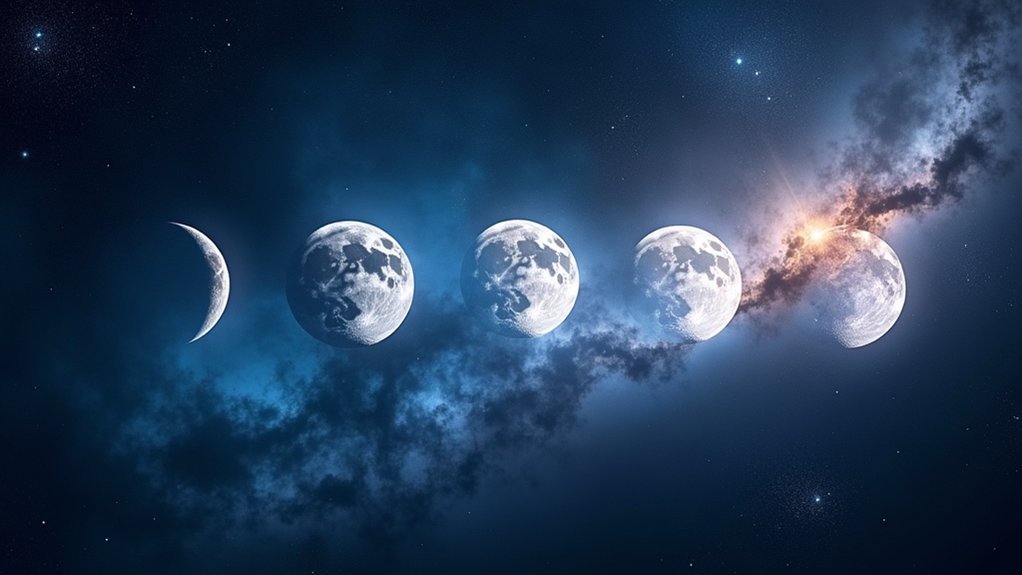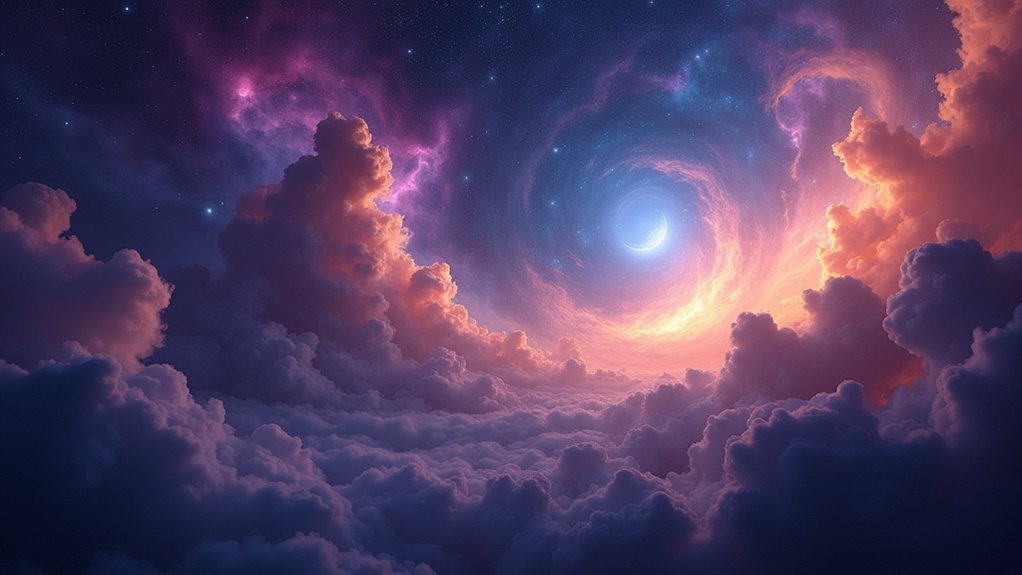For ideal nebula photography, new moons offer the darkest skies and best conditions for capturing faint details. You’ll get longer exposure times without moonlight interference. During first quarter phases, position your telescope at least 90° away from the moon and use narrowband filters, especially H-Alpha, when moon illumination exceeds 50%. For bright phases, target star clusters with shorter 30-60 second exposures. The right moon phase strategy can transform your cosmic captures from ordinary to extraordinary.
New Moon: Prime Opportunity for Nebula Detail Capture

When you’re planning to photograph nebulae, timing your session during a new moon can make all the difference in capturing stunning details. The absence of moonlight creates ideal conditions for imaging faint deep sky objects, allowing their subtle structures to shine through in your photographs.
During this phase, you’ll benefit from longer possible exposure times, which are essential for collecting the low-frequency data that reveals intricate nebula features. Plan your imaging sessions to coincide with peak astronomical darkness to maximize detail capture.
Your narrowband filters will also perform at their best during a new moon, efficiently isolating specific wavelengths emitted by emission and reflection nebulae. Without the moon’s light pollution, you’ll capture the true colors and delicate wisps that make nebulae so enchanting.
Understanding Moon Cycles for Astrophotography Planning
As you develop your nebula photography skills, mastering the lunar calendar becomes essential for planning productive imaging sessions. The moon phase directly impacts your ability to capture faint celestial objects, with each phase offering different opportunities and challenges.
- New moons provide ideal dark-sky conditions, perfect for capturing dim nebulae and their intricate details.
- Waxing crescent phases balance some moonlight while still allowing for effective deep-sky imaging.
- First quarter (50% illumination) requires careful exposure time management to prevent overexposure.
- Full moons greatly hinder nebula photography, though narrowband filters like H-Alpha can help mitigate interference.
First Quarter Strategies: Balancing Moonlight and Imaging Time

The first quarter moon presents unique opportunities for nebula photographers willing to adapt their techniques. With the moon 50% illuminated, you’ll find a sweet spot where moonlight actually enhances contrast for certain nebulae while still allowing deep-sky imaging.
While many avoid it, the first quarter moon creates ideal contrast for nebulae—a hidden advantage for adaptable astrophotographers.
Take advantage of the moon’s midnight setting time—you’ll gain several hours of dark sky afterward for prime shooting conditions.
Position your telescope to target nebulae at least 90° away from the moon to minimize light interference. For star clusters, keep exposures between 30-60 seconds, while brighter nebulae can handle longer exposures despite the ambient moonlight.
Don’t forget to employ a light pollution filter like the Optolong L-Pro to combat both moonlight and artificial light sources, greatly improving your final image quality.
Essential Filters for Nebula Photography During Bright Phases
When the moon brightens the night sky, you’ll need H-Alpha narrowband filters to cut through lunar interference and reveal those elusive nebula details that would otherwise be washed out.
Tri-band filter solutions allow you to capture multiple wavelengths simultaneously, maximizing your imaging efficiency during limited dark-sky windows between moon phases.
Light pollution filters like the Optolong L-Pro become your essential defenders against not only urban light domes but also the compounded challenge of moonlight, enabling productive nebula sessions even when conditions seem less than ideal.
H-Alpha Narrows Lunar Interference
Moonlight doesn’t have to ruin your nebula photography sessions if you’re equipped with the right narrowband filter.
The Astronomik 12nm Clip-In H-Alpha Filter specifically targets hydrogen emission wavelengths while blocking most of the moon’s interfering spectrum, allowing you to capture stunning nebulae even during bright moon phases.
- Selectively transmits H-Alpha wavelength (656.28nm) while rejecting moonlight
- Enhances detail in emission nebulae like Orion even during full moon
- Compatible with both DSLR (clip-in) and CCD camera setups
- Provides raw data for powerful HaRGB processing techniques
Your exposures and stacking workflow can continue despite lunar brightness when you’re using H-Alpha filters.
This targeted approach lets you maximize imaging time throughout the lunar cycle rather than limiting yourself to just the dark sky windows.
Tri-Band Solutions
Powerful yet versatile, tri-band filters have revolutionized nebula photography during bright lunar phases by simultaneously targeting multiple emission wavelengths.
Filters like the Optolong L-Pro isolate hydrogen, oxygen, and sulfur emission lines while blocking unwanted light pollution—making them perfect companions when shooting during challenging moon phases.
You’ll find these filters particularly effective when targeting faint nebulae that would otherwise be washed out by moonlight.
For best results, position your telescope toward targets located away from the moon’s position in the sky. This strategic placement maximizes the filter’s ability to reduce lunar interference.
Consider combining tri-band filters with techniques like narrowband imaging or frequency separation to further enhance detail, especially during extreme conditions like a supermoon.
With tri-band solutions, you can extend your nebula imaging opportunities throughout the lunar cycle.
Light Pollution Defenders
Despite the challenges of urban environments and bright moon phases, specialized light pollution filters can transform your nebula photography results. During a waning gibbous moon, when light interference remains significant, filters like the Optolong L-Pro become your essential allies for capturing celestial details.
- Narrowband H-Alpha filters excel at isolating emission nebulae wavelengths while blocking excess moonlight.
- Clip-in filters for DSLR cameras offer convenience without sacrificing image quality.
- Shorter exposure times (30-60 seconds) paired with filters yield better results for star clusters.
- Strategic color filter selection based on moon elevation helps combat atmospheric light pollution.
For long exposure nebula photography in light-polluted areas, combine these filtering techniques with stacking multiple images to reveal details invisible to the naked eye—even when the moon dominates your night sky.
Target Selection: Positioning Nebulae Away From Moon Glare
You’ll capture clearer nebula details by maintaining at least 100° angular distance from the moon’s position in the night sky.
Aim your telescope toward targets located in the opposite direction from where the moon sits, which dramatically reduces the light pollution affecting your images.
This strategic positioning lets you photograph fainter nebula features that would otherwise be washed out by moonlight’s intrusive glow.
Angular Distance Matters
When planning your nebulae photography sessions, maintaining considerable angular separation between your target and the moon becomes essential for capturing detail-rich images.
During bright moon phases, targets positioned more than 100° away from the moon will yield notably better contrast and detail in your final photographs.
- Select nebulae at least 100° from the moon to minimize light pollution interference
- Schedule your imaging session around the moon’s position in the sky
- Use the moon’s location to your advantage rather than avoiding night photography altogether
- Combine strategic positioning with appropriate filters for ideal results
This approach allows you to collect valuable low-frequency data even during challenging conditions.
When photographing IC 5146, positioning it over 100° from a bright super moon demonstrated how angular distance can transform an ordinary capture into a spectacular nebula image.
Opposite Sky Positioning
Beyond just measuring angular distance, a strategic approach called “opposite sky positioning” can greatly improve your nebula photography results.
When choosing a target, aim for objects positioned at least 100° away from the moon, ideally on the opposite side of the celestial sphere.
You’ll notice markedly better contrast and detail in your images when your target nebula sits far from the moon’s glare. For best results, time your imaging sessions when the moon sets or remains below the horizon. This technique proved particularly effective during IC 5146 imaging sessions.
If you’re shooting during brighter moon phases, consider focusing on star clusters or other objects located away from the moon’s path.
This positioning strategy helps preserve your low-frequency data and prevents moonlight from washing out the subtle colors in your nebulae.
Exposure Techniques for Different Moon Illumination Levels

The moon’s illumination level plays a crucial role in determining your astrophotography strategy for nebulae. When shooting during phases bright as a full moon, adapt your exposure techniques accordingly.
During a waning crescent moon, you’ll enjoy darker skies, but even bright phases aren’t deal-breakers if you adjust properly.
- Keep exposures short (30-60 seconds) for star clusters during full moon to prevent overexposure
- Utilize narrowband filters, especially H-Alpha, when moon illumination exceeds 50%
- Position your target at least 100° away from a super moon to minimize its brightness impact
- Capture low frequency information during moonlight, saving high frequency details for darker conditions
During post-processing, apply frequency separation techniques to enhance detail while minimizing moonlight’s washing-out effect.
Processing Methods to Combat Moonlight Interference
Despite the challenges posed by moonlight, effective post-processing techniques can salvage and even enhance your nebulae photographs.
When editing, employ moonlight scrubbing techniques to adjust color channels and minimize interference. Focus on capturing low-frequency base information quickly under bright conditions—Modochrome cameras excel here, gathering color data faster than detail.
Utilize special filters like H-Alpha narrowband filters to dramatically improve image quality by filtering out unwanted moonlight.
For best results, capture high-frequency details separately and composite them onto your base image. Implement non-destructive layer management with careful masking to enhance bright areas without degrading darker regions.
This approach preserves detail while reducing the moon’s impact on your final image, resulting in cleaner, more vibrant nebulae photographs even on moonlit nights.
Equipment Optimization for Low-Light Nebula Imaging

While processing techniques can improve nebula images in moonlit conditions, proper equipment selection forms the foundation of successful low-light astrophotography. Your camera choice is particularly vital—modified cameras like full-spectrum models dramatically enhance your ability to capture red nebulae emissions that stock cameras often miss.
* Modified cameras deliver superior sensitivity to hydrogen-alpha wavelengths, the predominant emission in many nebulae.
- Narrowband filters, especially H-Alpha, effectively cut through moonlight while isolating specific wavelengths.
- Employing a quality light-pollution filter like the Optolong L-Pro helps combat urban sky glow.
- Pair stable equipment combinations, such as an Orion ED80 telescope with an HEQ5 mount, for tracking precision.
Even during bright moon phases, you’ll achieve remarkable results with 30-second to 1-minute exposures when using this optimized equipment setup.
Budget-Friendly Moon Phase Planning for Maximum Results
Although equipment optimization provides technical advantages, strategically planning your nebula photography around lunar cycles offers a cost-free way to greatly improve results. Focus your sessions during waxing or waning crescent moons when illumination falls below 50%, considerably reducing moonlight interference.
When shooting during a quarter moon or brighter phase, position your target nebulae at least 100° away from the moon and employ narrowband filters to combat light pollution.
For star clusters during brighter phases, try shorter 30-second to 1-minute exposures to prevent overexposure while preserving detail.
Take advantage of clear nights with minimal moonlight to experiment with settings and techniques. This practice accelerates your learning curve without requiring expensive equipment upgrades, making moon phase planning an essential skill for budget-conscious astrophotographers.
Frequently Asked Questions
What Is the Best Moon Phase to Photograph?
You’ll get the best results during a new moon when there’s no moonlight to interfere with your photography. If you can’t wait, try during a waxing crescent when light pollution is still minimal.
How to Take Photos of Nebulas?
To take photos of nebulas, you’ll need a telescope or telephoto lens, a tracking mount, and a camera with manual settings. Shoot during new moon phases and use narrowband filters to capture their faint details.
Is the Moon Bad for Astrophotography?
Yes, the moon can be challenging for astrophotography. You’ll face reduced contrast when imaging faint objects, but you can still succeed using narrowband filters or by targeting star clusters with shorter exposures.
What Is the Most Beautiful Phase of the Moon?
Beauty is subjective, but you’ll likely find the waxing gibbous phase most stunning. It’s more than half-lit but not yet full, creating gorgeous contrast against the night sky while appearing brighter and larger.
In Summary
When photographing nebulae, you’ll achieve your best results by planning around moon phases. During new moons, you’ll capture maximum detail, while first quarter offers balanced opportunities with proper filters. Always position your targets away from lunar glare and adjust exposures according to illumination levels. With thoughtful processing and equipment optimization, you’ll create stunning nebula images regardless of your budget—simply by working harmoniously with the moon’s natural cycle.





Leave a Reply